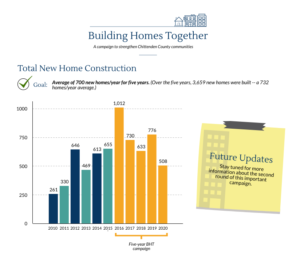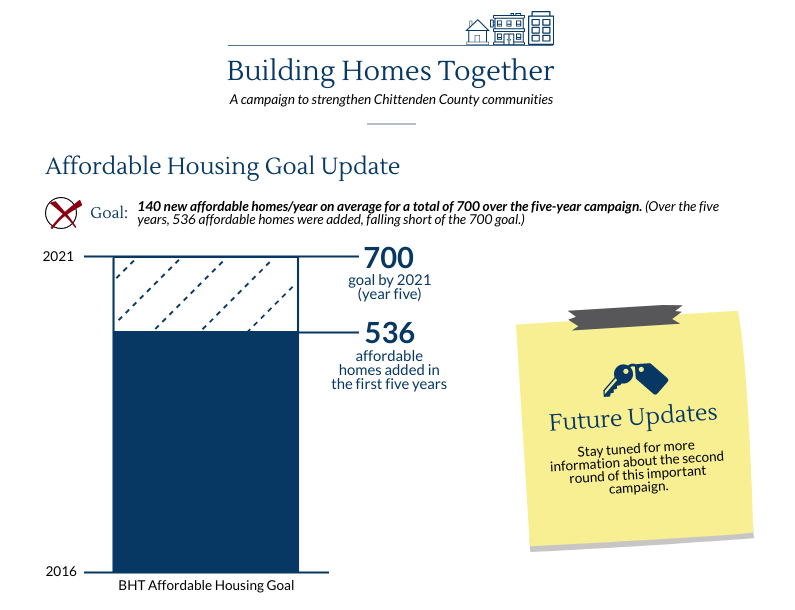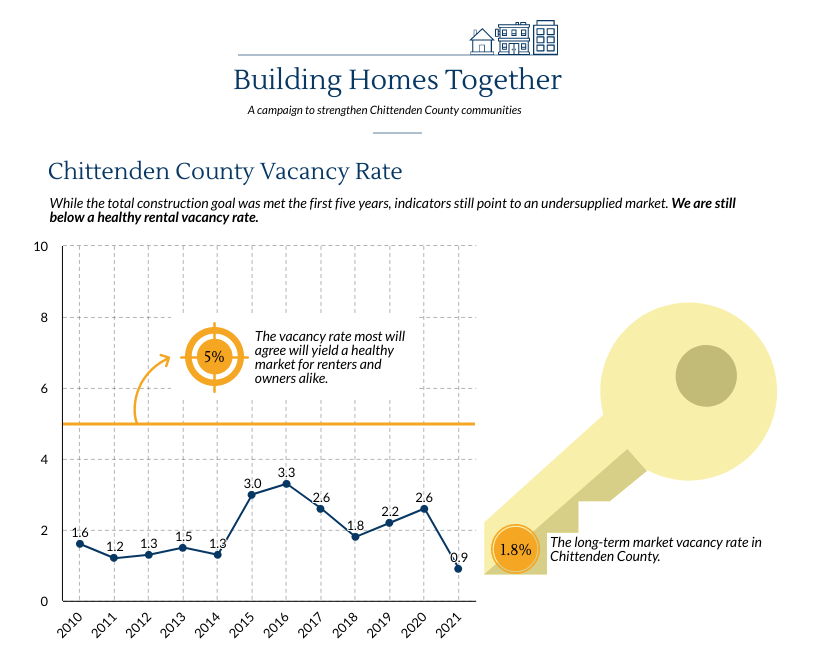Chittenden County housing and regional planning leaders announced the conclusion of a five year outreach, education, and advocacy campaign focused on the production of much needed housing in the county.
The Building Homes Together campaign (http://www.ecosproject.com/building-homes-together) pushed for 3,500 new homes between 2016 and 2020, with 700 of them permanently affordable to low-income households.
Over the five years, 3,659 net new homes were built, which eclipsed the target, but only 536 of them are permanently affordable falling short of the affordable home goal – even with the State’s $37 million Housing for All Revenue Bond helping to boost production slightly in 2018 and 2019. A data dashboard can be found here: https://ccrpc.maps.arcgis.com/apps/dashboards/0673704bdd9c4367b746effb6aea8e24
An unhealthy housing market disproportionately affects communities who already face barriers to housing access, particularly those who fall under the Fair Housing protected classes, such as folks with distinct needs around accessibility, families with children, and communities of color who have systemically been denied access to housing.
The campaign was led by the Champlain Housing Trust, Chittenden County Regional Planning Commission, and Evernorth (formerly known as Housing Vermont), and was supported by over one hundred leaders and advocates for housing.
The campaign’s final year ran headlong into the pandemic and its wide-ranging impact on housing affordability and availability ranging from supply chain and labor disruptions, an undercounted number of people living in precarious housing arrangements, and a wave of out-of-state buyers driving up costs.
Coupled with the need to address the systemic inequity for Black, Indigenous and People of Color caused by housing and lending policies and ongoing impacts of the coronavirus, campaign leaders signaled a redoubling of efforts to create a more balanced, equitable, and affordable housing market that invests in our communities and people.
“Our work is incomplete,” said Michael Monte, CEO of the Champlain Housing Trust. “Without adequate and affordable housing supply and services, our communities cannot thrive, our businesses cannot find workers, our vulnerable citizens will not be healthy and stable.”
A key indicator of a housing market that provides choices for people is the vacancy rate. Rentals, especially, are scarce and the vacancy rates keeps dropping from 3.3% in 2016 to 0.9% in 2020. A healthy market is commonly believed to have a 5% vacancy rate. The drop in vacant rentals directly impacts our most vulnerable communities, leading to renters being displaced, and those of whom who have jobs in Chittenden county end up shouldering the extra cost of commuting. In Vermont, Black communities are disproportionately renters, with only 21% of Black Households owning homes compared to the 72% of white homeownership, a much wider gap than the national average. Landlords can be more selective in who they rent to and discrimination is easier to disguise. Vermont has a higher than national homeowner
“Communities across the county are struggling to maintain enough production to satisfy the demand for housing,” explained Charlie Baker, executive director of the Chittenden County Regional Planning Commission. “Even with local housing committees advocating and developers wanting to build, we have had a hard time keeping up. It’ll take a sustained increase in housing production to start to fix the market.”
“What these past five years have shown is that when we work together with intention, we can reach an ambitious goal,” added Nancy Owens, co-president of Evernorth. “We can, and will, do more.”
For more information, visit:


